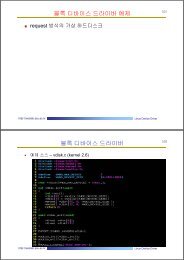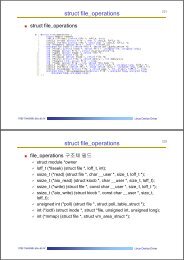Back-tracing in MIPS-based Linux Systems
Back-tracing in MIPS-based Linux Systems
Back-tracing in MIPS-based Linux Systems
You also want an ePaper? Increase the reach of your titles
YUMPU automatically turns print PDFs into web optimized ePapers that Google loves.
The <strong>MIPS</strong> Core<br />
� Brief history<br />
� In 1981, a team led by John L. Hennessy at Stanford University started work<strong>in</strong>g on what<br />
would become the 1st <strong>MIPS</strong> processor<br />
� In 1984, Hennessy left Stanford to form <strong>MIPS</strong> Computer <strong>Systems</strong><br />
� In 1992, SGI bought the company to guarantee the design would not be lost<br />
� The company became known as <strong>MIPS</strong> Technologies<br />
� Key concepts<br />
� Deep <strong>in</strong>struction pipel<strong>in</strong>es<br />
� One cycle for one <strong>in</strong>struction (elim<strong>in</strong>at<strong>in</strong>g <strong>in</strong>terlocks)<br />
� Core design licens<strong>in</strong>g<br />
� Broadcom (SiByte), IDT, LSI Logic, NEC, Philips, Toshiba, …<br />
� Very popular <strong>in</strong> develop<strong>in</strong>g CE products (BDP, DTV, PDA, STB, …)<br />
� Known as roll<strong>in</strong>g back stack-frames is not possible<br />
4<br />
Great Company Great People













